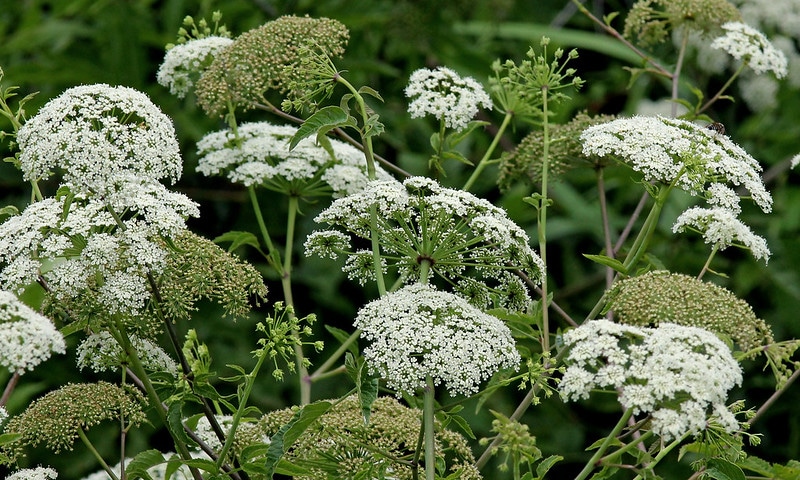Poison Hemlock: Danger and Threats in Florida
Poison hemlock is an aggressive invasive plant native to Europe that grows along roadsides, ditches, and other poorly drained regions. Florida. Poison hemlock can also be found in pastures, meadows, and open woodlands. All plant parts are poisonous to humans and animals if ingested, with the leaves and flowers being the most toxic. Poison hemlock poses a serious threat to Florida’s agriculture and natural areas.
How to Identify Poison Hemlock
- Stems
It has reddish or purple spots on stems, grows to 6-8 ft in height, and has hollow, ridged stems.
- Leaves
The leaves are large, fern-like, and deeply divided into 3-5 lobes. The leaves are hairless and have a smooth texture. The edges of the leaves are toothed.
- Flowers
The small white flowers of poison hemlock grow in umbrella-shaped clusters at the end of the stem. Poison hemlock blooms from April to June.
- Fruits
The fruits of the plant are small, oval-shaped, and greenish-brown that contain small black seeds.
Roots
Hemlock roots are large and white and are the most toxic part of the plant.
Common Look Alikes
Poison hemlock looks similar to several other plants, including water hemlock (Cicuta maculata), fool’s parsley (Aethusa cynapium), and wild carrot (Daucus carota). Poison hemlock can be distinguished from these plants by its hollow stems and large, deeply divided leaves.
Is Poison Hemlock Found In Florida?
One variety of Poison Hemlock, known as the Spotted Water Hemlock, is found here in Florida. It is easily mistaken for Poison Hemlock since they both have white flowers that grow in umbrella-like clusters. But, there are differences between the two. Water hemlock has dark green leaves that have a purple or red tinge on the stem while Poison Hemlock’s leaves are more of a dull green. Poison Hemlock has smooth leaves, while Water Hemlock’s leaves are hairy.
Spotted Water Hemlock can be found in all counties of Florida and blooms from April to June. The plant is most commonly found along roadsides, in pastures, in fields, and in other areas with disturbed soil. It can also be found growing in gardens, around buildings, and in other landscaped areas.
How Poisonous is Poison Hemlock?
All parts of the plant are poisonous, but the roots, leave, and seeds contain the highest concentration of the poison. Poison hemlock contains a compound called coniine, a highly toxic alkaloid. If consumed, this compound can cause serious health problems, including respiratory failure and death.
The amount of the poison present in the plant depends on several factors, including the time of year, the age of the plant, and growing conditions. Poison hemlock is most poisonous in the spring when the leaves are young and tender. The plant can also become more poisonous if growing in nutrient-rich soil.
Some Health Problems That Poison Hemlock Could Bring
- Nausea
- Vomiting
- Abdominal Pain
- Drowsiness
- Weakness
- Paralysis
- Respiratory Failure & Death
Ingesting any part of the plant, no matter how small, can be fatal.
How to Get Rid of Poison Hemlock In Your Backyard
Due to the danger, if you suspect that it is growing on your property, it is important to take steps to remove it immediately.
- Pull It Up By The Roots
One way to get rid of the plant is to pull it up by the roots. This is best done when the plant is young, and the roots are not too deeply entrenched in the soil. Wear gloves and long sleeves to protect your skin from the plant’s toxic sap. Be sure to dispose of the plant material in a sealed bag so that it cannot spread.
- Cut It Down And Destroy The Stems
If the plant is too large to pull up, you can cut it down and destroy the stems. Again, wear gloves and long sleeves to protect your skin from the plant’s toxic sap. Cut the plant down at ground level and remove the stems from the site. You can dispose of the stems in a sealed bag or burn them.
- Monitor The Area For Regrowth
Poison Hemlock is a persistent plant and will often regrow from even small pieces of stem or root. Be sure to monitor the area for regrowth and remove any new plants.
You can also take steps to prevent it from growing on your property in the first place. Be sure to remove any plant material that you see before it has a chance to spread and seed. Be vigilant in monitoring your property for new growth.
- Call a Professional
If you are not comfortable dealing with Poison Hemlock on your own, and you probably shouldn’t be, you can always call a professional. A professional will be able to safely and effectively remove the plant from your property. This plant poses a serious threat to your health and your family’s health. So, professional help is the best course of action to protect your family and prevent it from coming back.

